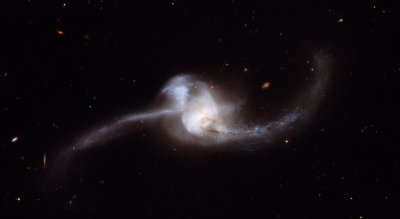Sky merger yields sparkling dividends [heic0912]
13 October 2009
A recent NASA/ESA Hubble Space Telescope image captures what appears to be one very bright and bizarre galaxy, but is actually the result of a pair of spiral galaxies that resemble our own Milky Way smashing together at breakneck speeds. The product of this dramatic collision, called NGC 2623, or Arp 243, is about 250 million light-years away in the constellation of Cancer (the Crab).
 |
|
HST/ACS view of the merger NGC 2623 |
The prominent lower tail is richly populated with bright star clusters - 100 of them have been found in these observations. The large star clusters that the team have observed in the merged galaxy are brighter than the brightest clusters we see in our own vicinity. These star clusters may have formed as part of a loop of stretched material associated with the northern tail, or they may have formed from debris falling back onto the nucleus. In addition to this active star-forming region, both galactic arms harbour very young stars in the early stages of their evolutionary journey.
Some mergers (including NGC 2623) can result in an active galactic nucleus, where one of the supermassive black holes found at the centres of the two original galaxies is stirred into action. Matter is pulled toward the black hole, forming an accretion disc. The energy released by the frenzied motion heats up the disc, causing it to emit across a wide swath of the electromagnetic spectrum.
NGC 2623 is so bright in the infrared that it belongs to the group of very luminous infrared galaxies (LIRG) and has been extensively studied as the part of the Great Observatories All-sky LIRG Survey (GOALS) project that combines data from some of the most advanced space-based telescopes, including Hubble. Additional data from infrared and X-ray telescopes can further characterise objects like active galactic nuclei and nuclear star formation by revealing what is unseen at visible wavelengths.
The GOALS project includes data from NASA/ESA's Hubble Space Telescope, NASA's Spitzer Space Telescope, NASA's Chandra X-ray Observatory and NASA's Galaxy Evolution Explorer (GALEX). The joint efforts of these powerful observing facilities have provided a clearer picture of our local Universe.
This data used for this colour composite were taken in 2007 by the Advanced Camera for Surveys (ACS) aboard Hubble. The observations were led by astronomer Aaron S. Evans. A team of over 30 astronomers, including Evans, recently published an important overview paper, detailing the first results of the GOALS project. Observations from ESA's X-ray Multi-Mirror Mission (XMM-Newton) telescope contributed to the astronomers' understanding of NGC 2623.
Notes for editors
The Hubble Space Telescope is a project of international cooperation between ESA and NASA.
Image credit: NASA, ESA and A. Evans (Stony Brook University, New York & National Radio Astronomy Observatory, Charlottesville, USA)
Contacts
Colleen Sharkey
Hubble/ESA, Garching, Germany
Tel: +49 89 3200 6306
Cell: +49 151 153 73591
E-mail: csharkey eso.org
eso.org
Aaron S. Evans
University of Virginia, Charlottesville, USA
National Radio Astronomy Observatory, Charlottesville, USA
Tel: +1-434-924-4896

